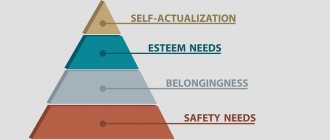In the late 60s and early 70s of the last century, Stanford University professor Walter Mischel conducted a series of experiments during which he proved that children with this character trait are more likely to achieve success in life. What this feature is and why the experience was called “marshmallow”, we will describe below.
To find out how to achieve success in life for you personally, find out your individual characteristics and assess your potential, come to the online program “Self-Knowledge”.
How the “marshmallow experiment” was carried out
To further explore this fact, Walter Mischel conducted an experiment that was later called the “marshmallow experiment.” He took 16 boys and 16 girls aged from 3.5 to 5.5 years as subjects. For each of the eight researchers there were 4 children - 2 boys and 2 girls.
The experimenter took the child into the room, sat him in a chair and placed one marshmallow on the table in front of him. After that, he offered a deal: “Listen, I’ll go out now for 15 minutes. While I'm gone, you can eat this marshmallow, or you can not eat it and get a second one as a reward. It's up to you."
Recommendations
- ^ a b c d f f
Michel, Walter;
Ebbesen, Ebbe B. (1970). "Attention in anticipation of satisfaction." Journal of Personality and Social Psychology
.
16
(2):329–337. doi:10.1037/h0029815. ISSN 0022-3514. - Michel, Walter; Shoda, Yuichi; Rodriguezes, Monica L. (1989). "Delay of gratification in children." The science
.
244
(4907):933–938. Bibcode:1989Science...244..933M. Doi:10.1126/science.2658056. PMID 2658056. - Ayduk, Ozlem N.; Mendoa-Denton, Rodolfo; Michel, Walter; Downey, Geraldine; Peek, Philip K.; Rodriguez, Monica L. (2000). “Regulating the Interpersonal Self: Strategic Self-Regulation for Coping with Rejection Sensitivity.” Journal of Personality and Social Psychology
.
79
(5):776–792. CiteSeerX 10.1.1.334.5423. Doi:10.1037/0022-3514.79.5.776. PMID 11079241. - Schlam, Tanya R.; Wilson, Nicole L.; Shoda, Yuichi; Michel, Walter; Ayduk, Ozlem (2013). “Preschoolers' delayed gratification predicts their body weight 30 years later.” Journal of Pediatrics
.
162
(1):90–93. Doi:10.1016/j.jpeds.2012.06.049. PMC 3504645. PMID 22906511. - ^ a b c
Shoda, Yuichi;
Michel, Walter; Peek, Philip K. (1990). “Predicting Adolescent Cognitive and Self-Regulatory Abilities from Preschool Learning Delays: Defining Diagnostic Conditions” (PDF). Developmental Psychology
.
26
(6):978–986. Doi:10.1037/0012-1649.26.6.978. Archived from the original (PDF) on October 4, 2011. - Calarco, Jessica McCrory (06/01/2018). "Why Rich Kids Do So Good on the Marshmallow Test." Atlantic Ocean
. Archived from the original on 2018-10-02. Retrieved 2018-10-03. - Jason, Collins. “Marshmallow Test Passed OK - Jason Collins Blog.” The marshmallow test passed well
. Archived from the original April 30, 2021. Retrieved July 28, 2019. - ^ a b c
Michel, Walter;
Ebbesen, Abbe B. (October 1970). "Attention in delay of gratification." Journal of Personality and Social Psychology
.
16
(2): 329–337. Doi:10.1037/h0029815 - via https://static1.squarespace.com/static/54694fa6e4b0eaec4530f99d/t/553d38ebe4b0e21d56a41327/1430075627649/Original+paper+on+the+Marshmallow+test+1969.pdf. - Kleinberg, Stephen L. (1968). "Future perspective and preference for delayed gratification." Journal of Personality and Social Psychology
.
8
(3): 253–257. doi:10.1037/h0025581. ISSN 1939-1315. PMID 5645229 - via EBSCO PsycARTICLES. - Michel, Walter; Gilligan (1964). "Delay of gratification, motivation for forbidden gratification, and response to temptation." Journal of Abnormal and Social Psychology
.
69
(4): 411–417. doi:10.1037/h0048918. PMID 14213305 - via EBSCO PsycARTICLES. - Shibut, John (1968). "Delay of gratification and severity of psychological distress among hospitalized psychiatric patients." Journal of Consulting and Clinical Psychology
.
32
(4):462–468. doi:10.1037/h0026106. ISSN 1939-2117. PMID 5666148 - via EBSCO PsycARTICLES. - Michel, Walter; Ebbesen, Ebbe B.; Rascoff Zeiss, Antonetta (1972). "Cognitive and attentional mechanisms in delay of gratification". Journal of Personality and Social Psychology
.
21
(2): 204–218. doi:10.1037/h0032198. ISSN 1939-1315. PMID 5010404. - Mischel, W.; Shoda, Y.; Peek, P. C. (1988). "The nature of adolescent competencies predicted by delayed preschool gratification." Journal of Personality and Social Psychology
.
54
(4):687–696. Doi:10.1037/0022-3514.54.4.687 - via PsycNET. - Eigste, Inge-Marie; Zayas, Vivian; Michel, Walter; Shoda, Yuichi; Ayduk, Ozlem; Dadlani, Mamta B.; Davidson, Matthew S.; Aber, J. Lawrence; Casey, B.J. (2006). "Predicting cognitive control from preschool to late adolescence and young adulthood" (PDF). Psychological Science
.
17
(6):478–484. Doi:10.1111/j.1467-9280.2006.01732.x. PMID 16771797. Archived from the original (PDF) on June 22, 2007. - "Marshmallow Checkpoints on a Biological Basis for Delayed Gratification." Science Daily
. September 1, 2011. Archived from the original on October 4, 2011. Retrieved October 4, 2011. - Casey, B. J.; Somerville, Leah H.; Gottlieb, Jan H.; Ayduk, Ozlem; Franklin, Nicholas T.; Askren, Mary K.; Jonides, John; Berman, Mark G.; Wilson, Nicole L.; Teslovic, Teresa; Glover, Gary; Zayas, Vivian; Michel, Walter; Shoda, Yuichi (August 29, 2011). "From the Cover: Behavioral and Neural Correlates of Delay of Gratification 40 Years Later." Proceedings of the National Academy of Sciences
.
108
(36):14998–15003. Bibcode:2011PNAS..10814998C. doi:10.1073/pnas.1108561108. ISSN 0027-8424. PMC 3169162. PMID 21876169. - "Revisiting the Marshmallow Test." University of Rochester
. October 11, 2012. Archived from the original October 17, 2012. Retrieved October 17, 2012. - Kidd, Celeste; Palmeri, Holly; Aslin, Richard N. (2013). “Sustainable Snacking: Children's Marshmallow Decisions Are Driven by Environmental Sustainability Beliefs.” Cognition
.
126
(1):109–114. doi:10.1016/j.cognition.2012.08.004. PMC 3730121. PMID 23063236. - ^ a b
Michel, Walter (1961).
"Father Absence and Delay of Gratification: Cross-Cultural Comparisons." Journal of Abnormal and Social Psychology
.
63
: 116–124. doi:10.1037/h0046877. PMID 14474528. - ^ a b
Michel, Walter (1966).
"Theory and Research on the Antecedents of Voluntary Delay of Gratification." In B. A. Maher (ed.). Progress in Experimental Research on Personality
. New York: Academic Press. pp. 85–131. - ^ a b
Michel, Walter;
Staub, Erwin (1965). "The Effects of Expectancy on Performance and the Expectation of Greater Reward." Journal of Personality and Social Psychology
.
2
(5): 625–633. doi:10.1037/h0022677. PMID 5838761. - ^ a b
Michel, Walter;
Grusek, Joan (1967). "Expectation of reward and punishment: The influence of time and probability on choice." Journal of Personality and Social Psychology
.
5
(1): 24–31. doi:10.1037/h0024180. PMID 6031227. - Watts, Tyler W.; Duncan, Greg J.; Quan, Haonan (2018). "The Marshmallow Test Revisited: A Conceptual Replication Exploring Associations between Early Delay of Gratification and Subsequent Outcomes." Psychological Science
.
29
(7):1159–1177. Doi:10.1177/0956797618761661. PMC 6050075. PMID 29799765. - Inga Kiderra (9 September 2021). "A new look at the marshmallow test." Medical Express
.
Results of the “marshmallow experiment”
As the researchers expected, most of the children did not wait and ate the marshmallows right away. Only 1/3 of the subjects received a reward in the form of a double portion.
Walter Mischel published the study in 1972. However, the most interesting things began after that. He followed the lives of the subjects until 2011. It turned out that children who delayed gratification received higher scores on the SAT exam (analogous to the Russian Unified State Exam), were less likely to have bad habits and become depressed, and also received higher salaries.
The further fate of the participants
Children who passed the marshmallow test grew up. The experiment is finally over. All these years, the researchers observed the participants and identified the same relationship between self-control in childhood and success in later life.
Participants who showed maximum persistence successfully passed the final test at the end of school. Their IQ level was an order of magnitude higher compared to other schoolchildren. All this allowed them to enter universities and continue studying.
The children achieved success not only in the area of study. Participants in the marshmallow experiment were less susceptible to addictions, bad habits, and emotional instability.
Those children who could not resist and ate the marshmallow showed less significant results. They did average or poorly on the final test and did poorly in their studies. The guys among them had bad habits, some of them showed signs of depression and could not cope with stress.
The researchers of the first experiment were confident that success in life directly depends on the child’s ability to exercise self-control.
Refutation of the “marshmallow experiment”
Don’t be upset if as a child you couldn’t restrain yourself and “ate marshmallows” right away. Scientists from the University of the City of New York doubted the results of Michel's experiment, since he had a very small sample - only 32 people.
To refute the “marshmallow experiment,” they took 900 children from different walks of life and carried out the same manipulations. It has been proven that the ability to delay gratification has virtually no effect on success in life. Children from rich families who waited for the experimenter to arrive, and children from poor families who did not receive a reward, had the same chances of becoming successful.
The difference in results is due to life situation. Parents often promise to buy toys or sweets for children from low-income families, but do not keep their promises due to lack of money. Therefore, such children are not inclined to trust other people and strive to get pleasure right away, because later it may not be there.
It is easier for children from families with a high level of income to restrain themselves and wait for the experimenter to arrive, because they know that they will always have something tasty lying around at home. For example, ice cream or the same marshmallow.
Despite the research of New York scientists, it is difficult to disagree with the fact that the ability to endure helps in life. If you cannot endure difficulties, you will quickly give up and achieve nothing.
We wish you to cultivate patience and become successful!
We also recommend reading:
- Storytelling
- 10 basic rules of financial literacy
- How to conduct life experiments
- The power of trust in business
- What will Asch's experiments teach society?
- Asch's experiment: are people really inclined to change their minds under pressure from the majority?
- 13 strange but true signs of high intelligence: scientists' opinions
- How to protect your child from smoking
- Lessons Children Can Teach Us
- 7 scientific ways to become happier
- Factors in a child’s intellectual development
Key words:1Self-knowledge
"Marshmallow Test" for adults.
First administered by psychologist Walter Mischel in the late 1960s, the Stanford Marshmallow Test has become a cornerstone of developmental psychology. Children from Stanford's Bing Preschool, ages four to six, were placed in a room with only a table and chair. One delicacy of the child's choice was placed on the table. In addition to marshmallows, scientists offered Oreo cookies and salty sticks
.
Each participant was told that if they could go 15 minutes without eating a treat, they would receive another one. Then he was left alone in the room with a treat. Follow-up studies of these people as adults showed a link between the ability to wait long enough to get a second treat and various forms of success in life, such as higher test scores. And conducted by Cornell University professor b. Casey's 2011 functional MRI of the brains of 59 participants (who are now in their forties) showed greater activity in the prefrontal cortex in those participants who delayed gratification for a greater reward in the future. I find this finding especially significant because research over the past two decades demonstrates that the prefrontal cortex plays a critical role in attention and emotion regulation. Each of us encounters one or another version of the “Marshmallow Test” every minute of our lives. It's not sugary treats that tempt us, but browser windows, phones, tablets, and (soon) smartwatches—all those devices that connect us to a worldwide information delivery system that affects us the same way marshmallows do for children.
We are tempted by sweets - and bad eating habits are formed. Today's agricultural industry and global trade, aimed at immediately satisfying our need for food, are radically different from the environment in which humanity as a species has evolved over millennia. The first people lived in a world where calories were constantly in short supply, and such a thing as sweet fruit was rare and precious. In relation to these delicacies, a response mechanism has developed in the brain, reflecting their significance (a surge of interest and excitement, a feeling of rewarded effort and satisfaction), which is very pleasant for us. And although we have transformed the world around us, radically reducing the physical effort spent on obtaining treasured calories, our brain remains the same as it was thousands of years ago, when our ancestors lived in caves. This discrepancy is what causes the agony many of us experience when trying to resist the temptation to eat something unhealthy.
A similar process occurs with our reaction to information. The environment that shaped us as a species was as poor in information as it was in calories. The features of this world—specifically, the members of the immediate community around us and our interactions with them—usually changed slowly and gradually. New information in the form of new members of society or new ways of interacting was an unusual and noticeable event that usually signaled something extremely important. Just as our brains have developed a response mechanism that values sugary treats, we have learned to pay close attention to new information about the people around us and our interactions with them.
But just as agricultural automation and mass trade have revolutionized the food industry, global communications capabilities have radically transformed the information environment. Now we are constantly bombarded with gigabytes of data about the people around us - and the very definition of “People Around us” has also changed fundamentally, now we intersect with more individuals in one hour than primitive man met in his entire life. All this puts our brains in front of a serious challenge - the adult version of the marshmallow “Lice Test.”
Not only are we constantly interrupted by messages, reminders, beeps and vibrations telling us that new information has arrived. We constantly distract ourselves by searching for new information. We answer calls while talking to other people. We check email while completing a complex task that requires full concentration. Increasing evidence suggests that these types of distractions prevent us from performing well, reduce productivity, and contribute significantly to stress.
And it doesn’t help us at all that multi-billion dollar industries are attracting their best minds and colossal resources to invent new ways to make money on this “Brain Dissonance”. We are at the mercy of an extremely powerful and sophisticated system designed for the express purpose of distracting us and capturing our attention. The revolution in agriculture and trade has certainly benefited humanity by allowing more people to live better lives than before. It would be unreasonable and fruitless to suggest turning the clocks back and going back in time. In the same way, the information revolution is moving our species forward by leaps and bounds, for which I am very grateful.
But just as we have to be smarter about our caloric intake, putting off impulses to eat healthier, we need to be more mindful of the information we consume. You need to resist the fascination of the intellectual equivalent of "Bad Calories" in order to allocate your time and attention more effectively. What can we do?
1 realize the problem. It is rare that awareness is enough for change, but it is a necessary first step. How often do you check what has arrived on your phone? Does this interfere with other things? How often do you interrupt your concentrated work to check your email? Does it distract your attention, requiring you to spend more time on an important task? How often do you glance at new posts on social networks? Does this lead to temporary losses? We take part in the Marshmallow Test all the time, are you a winner or a loser?
2 understand that our devices are tools and take control of them. These distractions are deliberately created by the creators of the tools we use. The best gadgets began to be perceived by us as integral parts of the surrounding reality or even as an extension of our body; ultimately we simply fail to perceive them as tools. What tools do you use? How do they distract you? How do they help you work? What messages and signals could you turn off? What restrictions can be placed on “Convenience” attributes that increase distractions?
3 manage emotions and cultivate the ability to analyze. No technical intervention will help if we do not want to work on ourselves. At the heart of this issue are our feelings: the excitement and interest generated by new information is what fuels our desire to be distracted again and again. Any change we seek will depend on our ability to recognize, understand and compensate for these feelings instead of blindly giving in to them. As I have already written, there is no simple recipe for managing emotions, but there are possible steps: physical activity and sufficient sleep are extremely important. Reflecting on life experiences using a diary or conversations with a coach can help us understand and calculate our emotional reactions. Perhaps even more beneficial would be at least a few minutes of daily meditation. They have been shown to have a powerful effect on our ability to be aware of our feelings and focus attention.








